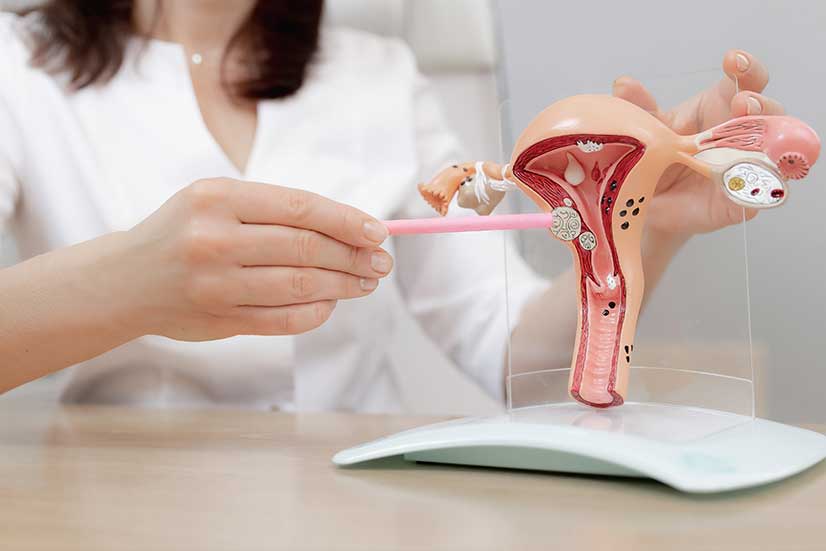 After detecting a fibroid, 35-year-old Nikitha, (name changed), a mother of two children suffered in silence the pain for fear of a surgery. Instead she relied on alternative medicine. It was only after pain aggravated and excessive vaginal bleeding that Nikitha, a highly qualified professional could gather courage to agree for surgical removal of uterus or Hysterectomy.
After detecting a fibroid, 35-year-old Nikitha, (name changed), a mother of two children suffered in silence the pain for fear of a surgery. Instead she relied on alternative medicine. It was only after pain aggravated and excessive vaginal bleeding that Nikitha, a highly qualified professional could gather courage to agree for surgical removal of uterus or Hysterectomy.
It was her husband, who was pillar of support to her – urging her to seek second opinion from doctors, alleviating her fear for surgery by encouraging her to read on the topic – finally post- surgery helping her return back to normal life. If it was discussion with her husband that helped her tide over her health issues, there are many women who are reluctant to consult doctors or even discuss with partners when they undergo health issues related to their reproductive organs.
there are many women who are reluctant to consult doctors or even discuss with partners when they undergo health issues related to their reproductive organs.
According to experts, two contributing factors for women not consulting doctors on time are unwanted fear for medical procedures, and wrong notions like shame or taboo associated to discuss the topic of vaginal hygiene and health. This is happening at a time when Hysterectomy has become one of the most frequently performed surgical procedures in many countries worldwide after caesarean section for various medical conditions. In India too the studies show that the number of Hysterectomy performed has increased maniifold over the years but point out that in-depth studies along with creating awareness among women is a necessity.
What is Hysterectomy?
A hysterectomy is the surgical removal of the uterus. In some cases, the doctor may also remove the ovaries and the fallopian tubes depending upon the gynaecological issues. A hysterectomy is performed for various reasons as the last resort ranging from chronic pain during menstruation, fibroids, infections and cancer.
Medical condition for hysterectomy
According to doctors many medical conditions, if consulted timely do not require surgical removal of uterus but can be treated with medicines and alternate therapies. Doctors may prescribe one or the other treatment options depending upon the condition of the patent. Treatment options include hormone therapy, oral contraception, pain medication, uterine artery embolization and endometrial ablation.
In some conditions, however, hysterectomy is the best choice of treatment. It is also performed as a life-saving surgery. It’s important to discuss your medical condition with your doctor and determine the best treatment option.
In some conditions, however, hysterectomy is the best choice of treatment. It is also performed as a life-saving surgery.
A hysterectomy is carried out –
- To surgically remove noncancerous tumors -leiomyomas or uterine fibroids
- To remove cervical or uterine cancer or other tumors that may lead to cancer
- For abnormal or excessive vaginal bleeding that cannot be controlled by other treatment methods.
- Chronic menses pain that cannot be controlled by other treatment methods
- Chronic pelvic pain related to the uterus but not controlled by other treatment.
- Uterine prolapse – weakening of the pelvic floor muscles and stretching of ligaments until they no longer provide enough support for the uterus.
- Other medical conditions connected to the lining of uterus like Adenomyosis, a condition in which the inner lining of the uterus grows into the muscles of the uterus or Endometriosis, a disorder in which tissue that normally lines the uterus grows outside the uterus.
Different types of hysterectomy
There are several different types of hysterectomy—partial hysterectomy in which a surgeon removes only a portion of the uterus, and leave the cervix intact; total hysterectomy, in which entire uterus and cervix are removed; and salpingo-oophorectomy, doctors remove the uterus along with one or both the ovaries and fallopian tubes.
Total hysterectomy: Removing the uterus and cervix, keeping the ovaries.
Supracervical hysterectomy: Removing just the upper part of the uterus
Total hysterectomy with bilateral salpingo-oophorectomy: Removing the uterus, cervix, fallopian tubes and ovaries.
Radical hysterectomy with bilateral salpingo-oophorectomy: Usually performed to remove cancer, it involves the removal of the uterus, cervix, fallopian tubes, ovaries, the upper portion of the vagina and some surrounding tissue and lymph nodes.
Know about hysterectomy procedure
Prior to hysterectomy, you can speak with top gynaecologist near you to know more about the type of hysterectomy that needs to be performed and the Gynae hospital procedures involved. A hysterectomy can be performed under a general or local anaesthesia. In an abdominal hysterectomy, surgeon removes the uterus through a large incision in the abdomen. The incision can be either vertical or horizontal. It will leave a scar. While, in a vaginal hysterectomy, the surgeons makes a small incision inside the vagina and from there the uterus is removed. Since there is no external incision, there is no visible scar. While, in Laparoscopic Hysterectomy surgeons make 3 to 4 tiny incisions in the abdomen and inserts a laparoscope, a long and thin tube fitted with a high intensity light, and a camera.
Life post-hysterectomy
After the surgery, depending on the type of hysterectomy that has been carried out, you may need hospitalisation ranging from one to five days.
A hysterectomy also brings some permanent changes that a woman needs to understand and cope with. After the surgery, you’ll no longer have menstrual periods and will not be able to become pregnant.
As health experts suggest always the best way to get rid of fear for a surgery is to know more about the procedure and to better equipped with the knowledge about your health condition. Also, it is must for women and girls in reproductive age to shed any unnecessary taboo to discuss health issues associated with reproductive system and vaginal hygiene. As World Health Organisation puts it ” Reproductive health is a state of complete physical, mental and social well-being and not merely the absence of disease or infirmity, in all matters relating to the reproductive system and to its functions and processes.”






